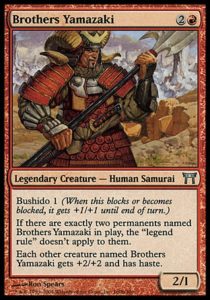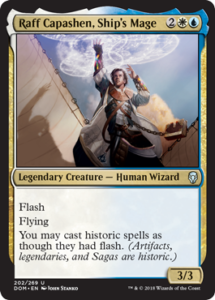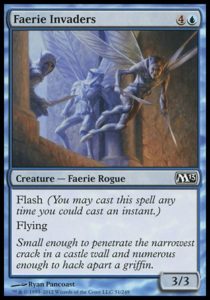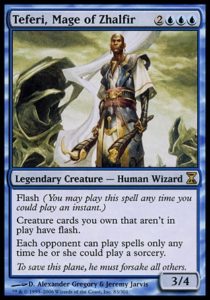Yesterday, we met the entire crew of the good ship Weatherlight, and one face stood out of the crowd:
Danitha Capashen, Paragon is reminiscent of their ancestor, the sword-wielding Gerrard Capashen. Raff Capashen, however, eschews their martial prowess for spellcasting. That’s an interesting story point that I’m excited to see develop.
Looking at Raff’s card, I’m enthralled. He’s a Phantom Monster with flash and an extra ability to boot. Sure, he’s legendary, so you’re punished for drawing extra copies, but as a likely powerful uncommon, you’re unlikely to have extra copies in the first place.
Still, there’s something simple nagging at me. Just how good are Raff’s stats?
They Make ’em Better than they used to
Once upon a time, Aven Windreader was a solid creature. As time went on and creatures got better (because they were mostly terrible when Magic began and have been improving ever since), we met cards like Spire Monitor, which were often two-for-ones because they could ambush a creature in combat and then beat down. However, their descendants, Stormrider Spirit and Wind Strider have been less than stellar (despite having access to increasingly powerful tribal synergies). We’ve reached a juncture were Wind Drake and Spire Monitor are fairly weak commons.
Now, none of this means that Raff Capashen, Ship’s Mage isn’t going to be incredible in Limited—Phantom Monster is likely still too good for common and costing one mana less than Wind Strider is a huge deal (not to mention the third ability). Still, it’s worth noting that an insane uncommon like Skymark Roc might not have quite the same impact today as it did many years ago. Ixalan and Amonkhet are worlds full of two drops with three power—in such environments, a 3/3 flash is often unable to ambush and eat anything good and is instead overcosted.
But How about that Third Ability, though?
So, what is the value of giving flash to historic spells, sagas, and legends? Giving your legendary creatures flash is the most obvious benefit—you can now ambush your opponent with all sorts of stuff, not to mention they get to live in fear of you having open mana and cards in hand. Normally, the odds of you actually having another legendary creature would be low, but with a minimum of one legendary per pack, Dominaria provides ample opportunity to utilitze this ability. Casting legendary sorceries on your opponent’s turn is likely less valuable—if they’re dramatic proactive effects (like big sorceries tend to be) you’ll probably want to be proactive with them.
Evaluating this ability is difficult without knowing what common and uncommon artifacts and sagas are going to be in the set (let’s not worry about mythic rare Planeswalkers right now). In general, giving sorceries and non-creature permanents flash isn’t a huge boon, since their effects are usually meant to happen on your turn and have to make sense outside of combat. Giving your sagas flash speeds them up by a turn, which might be valuable, say with History of Benalia. And we have seen uncommon sagas with trick-like first stages: Triumph of Gerard and Time of Ice.
Still, I expect this ability to be more trinket text than primary motivator: if you’ve resolved Raff uncontested, you’ve got a big flying creature to tussle with. It making some segment of your deck a bit better is nice, but only going to benefit you some fraction of the time.
 It’s interesting and exciting seeing Magic internalize the lessons of Kamigawa (which had an obscure legendary theme) and Dragons of Tarkir (which lacked a common dragon) in Dominaria. The entire set is dedicated to history. Thanks to historic becoming a game term, legendary will be referenced on cards of all rarities, encouraging players to seek them out and recognize their importance. I didn’t think we’d ever again see uncommon legendary creatures outside of a supplemental set and I’m excited to see how they play. Perhaps this might even lead to a change where the Legend rule is done away with entirely and legendary creatures will no longer need to essentially choose whether to be best in Commander or to be best in every other Constructed format and Limited.
It’s interesting and exciting seeing Magic internalize the lessons of Kamigawa (which had an obscure legendary theme) and Dragons of Tarkir (which lacked a common dragon) in Dominaria. The entire set is dedicated to history. Thanks to historic becoming a game term, legendary will be referenced on cards of all rarities, encouraging players to seek them out and recognize their importance. I didn’t think we’d ever again see uncommon legendary creatures outside of a supplemental set and I’m excited to see how they play. Perhaps this might even lead to a change where the Legend rule is done away with entirely and legendary creatures will no longer need to essentially choose whether to be best in Commander or to be best in every other Constructed format and Limited.
That’s all for today, friends, but that’s not all for this week. Check back on Thursday for a very exciting bonus Drawing Live where we’ve got something seriously awesome waiting for you.
And, as always, thanks for reading.
—Zachary Barash
Zachary Barash is a New York City-based game designer. He works for Kingdom Death: Monster, has a Game Design MFA from the NYU Game Center, and does freelance game design. When the stars align, he streams Magic.
His favorite card of the month is Skymark Roc. It’s painfully good when played on curve but isn’t unbeatable. It even tells a nice little story—it delivers your opponent a present as its clawing at their eyes.




